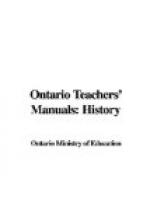FORMS I AND II
TYPE LESSON IN THE “STORY STAGE”
The aim of this lesson is to give the pupils the story of “Moses and the Burning Bush,” and at the same time to arouse an interest in stories.
As a preparation for the lesson, the teacher should secure pictures, or make sketches, illustrating (1) Moses tending his flocks, (2) the Burning Bush, (3) the rod turning to a serpent, (4) Moses setting out to do God’s will. The pictures and sketches are used to make real the verbal story.
A few questions recalling the earlier events in Moses’ life should be answered by the pupils, for example: Moses as a baby in the bulrushes, his adoption by the Princess, his life in the palace, his killing of the Egyptian, the cause of his flight into Midian.
The teacher should then narrate in clear, simple language the story of Moses in Midian, dividing it into parts such as: Moses at the well, his home with Jethro, the appearance of the Burning Bush, his talk with God, his excuses, God’s proof of power to help, his setting out to do God’s will.
In Form I it may be advisable to question, during the story, to ascertain if the language and ideas are understood, but reproduction of each part as it is narrated will probably result in a loss of attention and a lack of interest in the remainder of the story. The reproduction should, therefore, be taken after the completion of the story.
In Form II very short topic-phrases may be written on the black-board. These will serve as a guide to the pupils in the oral or written reproduction that follows.
If illustrated story-books containing this story are in the library, pupils of Form II may be asked to read them.
When practicable, an exercise in sight reading may follow this kind of lesson. The teacher may have slips containing sections of the story prepared beforehand, and may give them to the pupils for sight reading.
FORMS I AND II
THE FIRST THANKSGIVING
Materials: A set of pictures showing “The Mayflower in Plymouth Harbour”; “The Landing of the Pilgrims”; “The Pilgrims going to Church”; “Plymouth Rock”; “The Spinning Wheel.” (Perry Picture Co. pictures)
A map of the western coast of Europe and the eastern coast of America drawn on the black-board.
Introduction: A talk on Thanksgiving Day as celebrated now—the returning of thanks to God for a bountiful harvest, the general good-will prevailing, the dinner. How and when did this custom originate?
Presentation: The teacher tells the story of the emigration of the Pilgrim Fathers, and shows the pictures that illustrate the different parts of the story. The voyage is traced on the map and the landing-place in America marked.
This should be followed by a spirited reading of Mrs. Hemans’ The Landing of the Pilgrim Fathers, and the telling of The First Thanksgiving. (See Appendix.)




